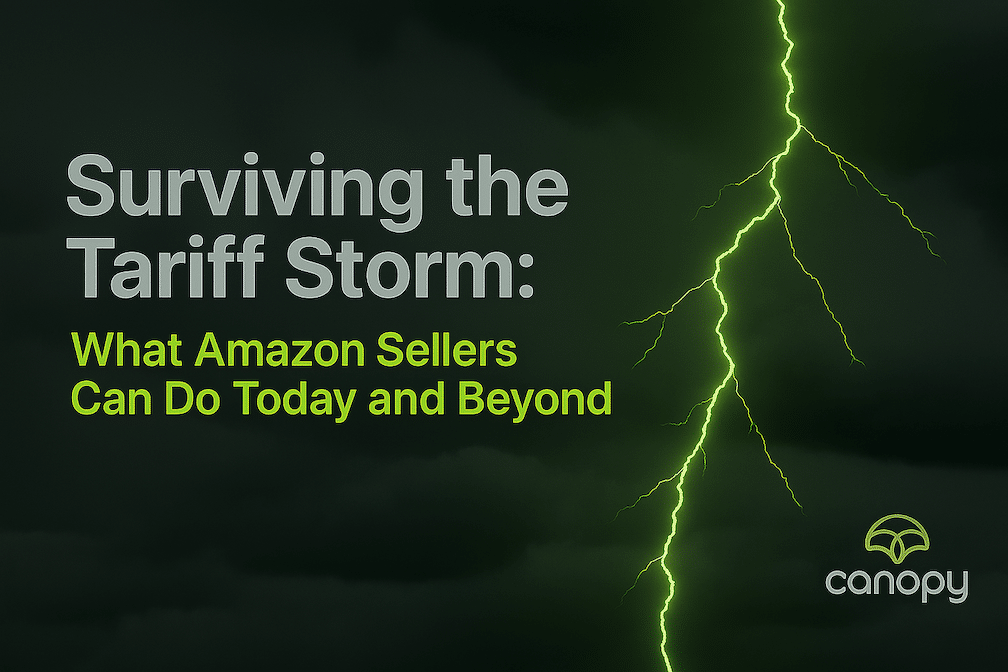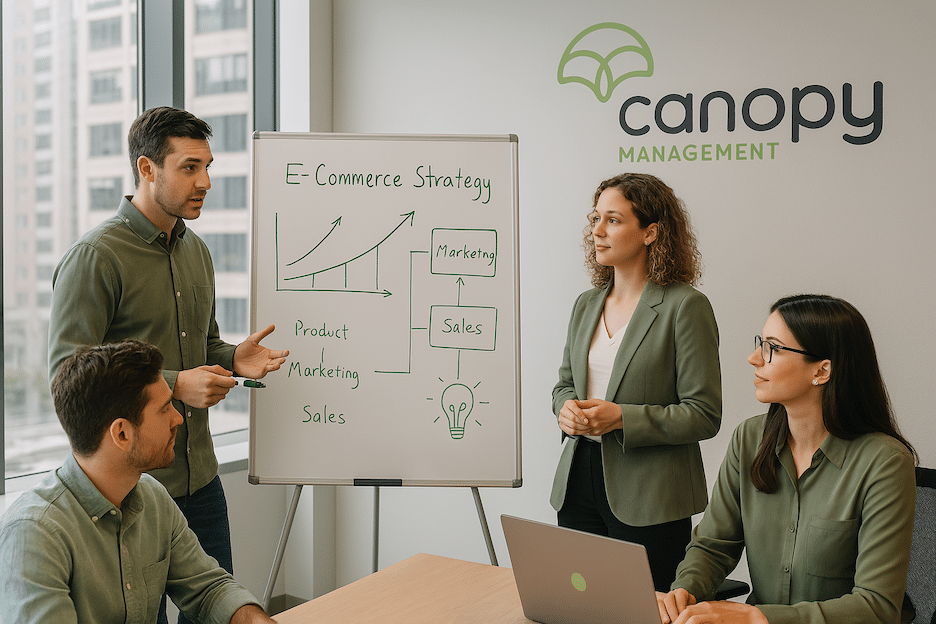Surviving the Tariff Storm: What Amazon Sellers Can Do Today and Beyond
Transform tariff threats into profit opportunities: These Amazon tariff strategies can launch you ahead while competitors scramble

“Another day, another tariff hike.” That’s becoming the unofficial motto for Amazon sellers in 2025, as trade tensions reshape the e-commerce battlefield with relentless unpredictability.
While your competitors are panic-raising prices or watching their margins vanish, savvy sellers are transforming these tariff hurdles into strategic advantages.
Think of tariffs not as unavoidable taxes, but as a game of chess where foresight and adaptability determine who thrives and who merely survives in the ever-evolving Amazon ecosystem.
Ready to Start Growing Your Amazon Brand?
Canopy’s Partners Achieve an Average 84% Profit Increase!
Find out more3 Amazon Tariff Strategies that Sellers Can Implement TODAY to Weather the Storm
Need immediate relief from tariff pressures? Here are three actionable Amazon tariff strategies for 2025 you can implement right now to stabilize your business:
1. Recalculate Landed Costs and Adjust Pricing
When tariffs hit, your first priority is understanding exactly how they affect your bottom line:
- Run the numbers immediately: Use third-party tools like Finale Inventory and Zonos Landed Cost, or Amazon’s FBA Revenue Calculator to reassess your landed costs under the new tariff rates. This quick analysis will reveal which products face shrinking margins and require immediate attention.
- Implement strategic price adjustments: Rather than dramatic price hikes that could tank your conversion rates, test incremental increases (3-5%) on your less price-sensitive items first. Monitor competitor pricing closely to ensure your adjustments maintain marketplace competitiveness.
- Quick win: Sort your products by profit margin impact and prioritize adjustments on items where tariffs have caused the greatest percentage decrease in profitability.
2. Review Inventory and Restock Strategies
Smart inventory management can provide immediate tariff relief:
- Optimize current inventory levels: Use third-party tools like SoStocked or Netstock to analyze sales velocity and adjust reorder points. This prevents over-purchasing now-expensive inventory while avoiding costly stockouts.
- Consider strategic stockpiling: For your consistent best-sellers, calculate whether ordering larger quantities of items already in the U.S. makes financial sense to delay the impact of import tariffs on your cash flow.
- Quick win: Identify any inventory currently in transit that will be subject to new tariff rates and prepare your cash flow accordingly to avoid unexpected financial strain.
3. Negotiate Terms with Suppliers Today
Don’t wait to have critical conversations with your suppliers:
- Initiate cost-sharing discussions: Reach out to suppliers immediately to discuss options for absorbing part of the tariff increase. Long-standing relationships often have flexibility, especially if you can commit to continued business.
- Renegotiate shipping terms: Request a switch from EXW (Ex Works) to FOB (Free on Board) terms, which can shift some shipping responsibilities and costs back to the supplier, providing immediate relief.
- Quick win: Ask suppliers for extended payment terms (Net-60 instead of Net-30) to improve your cash flow while adapting to the new tariff environment.
Taking these immediate actions can stabilize your business while you implement the following longer-term strategies.

7 Long-Term Strategies for Navigating Amazon Tariffs in 2025
While the above tactics provide immediate relief, sustainable success requires a comprehensive approach. Here are seven proven long-term strategies to navigate tariff challenges while maintaining your competitive edge:
1. Diversify Your Supply Chain to Reduce Tariff Exposure
Relying too heavily on manufacturers from a single country makes your Amazon business vulnerable to tariff fluctuations and supply chain disruptions. While Chinese suppliers remain popular due to their cost-effectiveness and efficiency, Amazon sellers should strategically expand their sourcing network to include:
Alternative Manufacturing Hubs for Amazon Products:
- Vietnam: Rapidly expanding manufacturing capabilities with competitive pricing and growing expertise in consumer electronics, furniture, and textiles
- India: Excellent for textiles, leather goods, and increasingly electronics with favorable trade agreements in certain product categories
- Taiwan: Superior quality in tech components and hardware products with established quality control systems and intellectual property protections
Don’t overlook domestic manufacturing options for Amazon sellers either. Though U.S.-based suppliers typically have higher production costs, they eliminate tariff concerns entirely while offering faster shipping times, simplified logistics, and “Made in USA” marketing advantages. A geographically diversified supply chain provides resilience against future trade policy changes and helps maintain healthy profit margins on Amazon.
2. Optimize Product Tariff Classifications for Amazon Imports
Every imported product sold on Amazon receives a specific Harmonized Tariff Schedule (HTS) code that determines its tariff rate when entering the United States or other markets. Ensuring your Amazon inventory is correctly classified—or strategically modified to qualify for lower tariff categories—can lead to substantial cost savings and improved profit margins.
Classification Optimization Approaches for Amazon Sellers:
- Consult with customs brokers or trade compliance specialists to review your current HTS codes and identify potential misclassifications that may be costing you money
- Investigate “tariff engineering” opportunities—strategic minor product modifications that could legally qualify your items for lower duty rates without compromising quality
- Document all classification decisions thoroughly with proper supporting evidence to defend your position if questioned by customs authorities during import
- Research Section 301 tariff exclusions that may apply to your specific product categories on Amazon
While this tariff optimization strategy requires some upfront investment in professional guidance, the long-term savings can be significant—many Amazon sellers report 5-15% reductions in landed costs through proper classification reviews.
3. Develop Deeper Supplier Relationships
Beyond the immediate negotiation tactics mentioned earlier, cultivating strategic supplier partnerships can yield long-term tariff relief:
Strategic Supplier Partnership Development:
- Co-develop products with your key manufacturers to create designs optimized for both quality and tariff efficiency
- Explore joint ventures or exclusivity agreements that incentivize suppliers to share tariff burdens
- Investigate whether your suppliers can establish fulfillment operations in tariff-advantaged countries
- Consider direct investment in your most critical suppliers to gain more control over pricing and operations
Suppliers value long-term relationships and may be willing to collaborate on creative solutions that help both parties weather trade policy volatility.

4. Implement Advanced Pricing Intelligence
Building on your immediate pricing adjustments, develop sophisticated pricing systems:
Long-Term Pricing Strategy Development:
- Invest in AI-powered pricing tools that dynamically adjust to market conditions and competitor movements
- Segment your product catalog by price sensitivity and tariff impact to create nuanced pricing rules
- Test premium positioning for certain products, emphasizing quality and features over price
- Develop product bundles that combine high-margin items with tariff-impacted products to maintain overall profitability
The most successful Amazon sellers in tariff-volatile categories use data-driven pricing strategies that balance immediate profitability with long-term market position.
5. Redesign Products for Tariff Efficiency
Consider how your products themselves might be reimagined to reduce tariff exposure:
Product Engineering for Tariff Optimization:
- Evaluate materials and components that trigger higher tariff rates and research alternatives
- Explore modular product designs where high-tariff components can be shipped separately or sourced domestically
- Consider whether slight changes to dimensions, materials, or functionality might qualify for more favorable HTS classifications
- Develop new product lines specifically designed for tariff efficiency from the ground up
While requiring more substantial investment, product redesign can create sustainable competitive advantages that extend beyond the current tariff situation.
6. Enhance Amazon Product Listings and Marketing to Offset Tariff Impacts
When absorbing all tariff costs isn’t feasible for your Amazon business, increasing sales volume and conversion rates through improved marketing becomes essential. Strategic listing optimization allows you to maintain profitability without implementing dramatic price increases that could hurt your competitive position.
Amazon Listing Enhancement Strategies:
- Invest in professional product photography and videography to showcase quality and value, justifying any necessary price adjustments
- Optimize product titles and descriptions with high-performing keywords targeting purchase-ready customers
- Highlight unique selling points and superior quality that differentiate your offerings from lower-priced competitors
- Implement systematic A/B testing on images, bullets, and descriptions to continuously improve listing performance
- Add comparison charts showing how your product delivers better value despite potential price differences
Amazon Marketing Refinements:
- Analyze and optimize Amazon PPC campaigns to reduce ACoS (Advertising Cost of Sale) while maintaining visibility
- Explore Sponsored Brand and Sponsored Display options for expanded visibility across the Amazon ecosystem
- Leverage external traffic sources through social media and email marketing to reduce dependency on Amazon’s internal traffic
- Build a compelling brand story that creates emotional connections with customers, reducing price sensitivity
- Develop post-purchase email sequences that boost review rates and encourage repeat purchases
Case Study: Successful Tariff Management Through Marketing
An electronics accessories seller faced a 15% tariff increase on their main product line. Rather than raising prices proportionally, they:
- Enhanced product imagery showing durability and premium materials
- Added comparison tables highlighting their superior warranty and customer service
- Implemented targeted PPC campaigns focusing on high-intent keywords
- Created bundle offers that improved perceived value
Results: Despite a modest 8% price increase, their conversion rate actually improved by 3.2%, and overall revenue increased by 11%, effectively offsetting the tariff impact while growing market share.
Well-executed marketing initiatives can increase both sales volume and customer loyalty, offsetting tariff-related margin compression for Amazon sellers in 2025.

7. Stay Informed and Adapt Quickly to Changing Trade Policies
In the dynamic world of international trade and e-commerce, tariff policies can change rapidly and with little notice. Amazon sellers who stay ahead of these developments gain a crucial competitive advantage through early adaptation.
Strategic Information Management for Amazon Sellers:
- Subscribe to specialized trade publications and government information sources like the U.S. Trade Representative website and International Trade Administration updates
- Join Amazon seller communities like FBA Forums and Facebook groups where experienced peers share proven tariff management strategies
- Establish relationships with customs brokers and trade consultants who can provide early insights on policy changes affecting your specific product categories
- Investigate government relief programs, exclusion processes, or tariff exemptions that might apply to your Amazon business
- Set up Google Alerts for your product categories + “tariffs” to receive relevant news automatically
Key Takeaway: Amazon sellers who adapt quickly to changing circumstances consistently outperform those who react after trade policy changes have already impacted their operations. Proactive monitoring saves an average of 8-12% in unexpected tariff costs compared to reactive approaches.

Frequently Asked Questions About Amazon Selling and Tariffs
Q: How do I know which of my Amazon products are affected by tariffs?
A: Review your product’s HTS codes on the USITC website and cross-reference with current tariff lists. Canopy’s Tariff Scanner tool can also automatically identify affected products in your inventory.
Q: Can I legally avoid paying tariffs on products I sell on Amazon?
A: While you cannot evade legally applicable tariffs, you can minimize exposure through legitimate strategies like diversifying supply chains, utilizing Free Trade Agreements, exploring tariff exclusions, and proper product classification.
Q: How much of my tariff costs should I pass on to Amazon customers?
A: This varies by product category and competition level. Our research shows that successful Amazon sellers typically absorb 30-40% of tariff increases while passing 60-70% to customers through strategic, gradual price adjustments.
Q: Are tariff costs tax-deductible for my Amazon business?
A: Yes, tariffs paid are generally considered part of your cost of goods sold and are tax-deductible business expenses. Consult with a tax professional familiar with e-commerce businesses for your specific situation.
Q: How quickly do Amazon competitors typically adjust prices after tariff increases?
A: Our analysis shows that approximately 35% of Amazon sellers update pricing within 7 days of tariff implementation, 45% within 14 days, and the remaining 20% take a month or longer, creating a competitive opportunity for agile sellers.
Why Partner with Canopy: Your All-in-One Amazon Success Partner
While navigating tariffs requires strategic planning, truly thriving on Amazon demands excellence across multiple dimensions. That’s where Canopy comes in—our comprehensive agency offers end-to-end Amazon expertise that extends far beyond tariff management.
How Canopy Elevates Your Entire Amazon Business:
- Strategic Account Management: Our dedicated Amazon specialists become an extension of your team, crafting customized roadmaps for sustainable growth while adapting to challenges like tariff increases. We’ve helped brands increase their Amazon revenue by an average of 32% within the first six months of partnership.
- Listing Optimization & SEO Mastery: Our in-house content team transforms your product listings with conversion-focused copy, keyword optimization, and competitive positioning. Canopy-optimized listings see an average 24% improvement in organic visibility and 18% higher conversion rates.
- Premium A+ Content Creation: Elevate your brand story with stunning enhanced brand content that educates customers and justifies premium pricing. Our A+ content designers craft immersive experiences that have increased average order value by 15% for our clients—crucial when offsetting tariff-related price adjustments.
- Data-Driven Inventory Management: Our proprietary forecasting models help you maintain optimal inventory levels despite supply chain disruptions, preventing both costly stockouts and excessive storage fees. Canopy clients reduce inventory carrying costs by an average of 21% while improving in-stock rates.
- Customer Service Excellence: Our specialized teams manage customer inquiries, reviews, and issues, maintaining your brand reputation even during periods of pricing adjustments. Our proactive approach has helped clients achieve and maintain 4.7+ star ratings across their product catalogs.
- Brand Protection & Growth: From unauthorized seller monitoring to strategic brand registry utilization, we safeguard your brand equity while creating expansion opportunities. Our brand defense strategies have helped clients reduce unauthorized sales by over 85%.
- Advanced Advertising Management:
- Amazon PPC: Our certified PPC specialists optimize your advertising spend across Sponsored Products, Brands, and Display, achieving an average 24% reduction in ACoS while expanding reach.
- Amazon DSP: Access the power of programmatic advertising with our demand-side platform expertise, allowing you to reach customers across the entire shopping journey both on and off Amazon.
- International Expansion Support: When diversifying beyond tariff-affected markets, our global team provides market-specific expertise for successful launches across North America, Europe, and Asia-Pacific regions.
Ready to Start Growing Your Amazon Brand?
Canopy’s Partners Achieve an Average 84% Profit Increase!
Find out moreClient Success Story: Weathering Tariff Challenges
A home goods brand facing a 25% tariff increase partnered with Canopy for a holistic approach. While implementing the strategic pricing and supplier negotiations covered in this article, our team simultaneously:
- Redesigned their product detail pages with enhanced lifestyle imagery and benefit-focused content
- Created comparison charts highlighting their superior quality versus lower-priced alternatives
- Implemented targeted PPC campaigns focusing on premium positioning
- Developed an A+ content strategy emphasizing craftsmanship and durability
Results: Despite necessary price increases, they maintained 93% of their pre-tariff conversion rate while increasing average order value by 17%, effectively preserving overall profitability.
“Canopy’s comprehensive approach turned what could have been a devastating tariff situation into an opportunity to strengthen our brand positioning. Their expertise across every aspect of our Amazon business made all the difference.” — Sarah L., CEO
Ready to transform tariff challenges into Amazon growth opportunities? Visit Canopy today for a free Amazon performance audit and consultation. Our integrated approach helps sellers not just survive tariff impacts but thrive across all aspects of Amazon selling.
Canopy Management is a full-service marketing agency for Amazon, Walmart, and TikTok sellers. Our team consists of multi-million dollar, omni-channel entrepreneurs, industry leaders, and award-winning experts.
Ready to Start Growing Your Amazon Brand?
Canopy’s Partners Achieve an Average 84% Profit Increase!
Find out more


